
Cochise Airlines
TIMETABLES
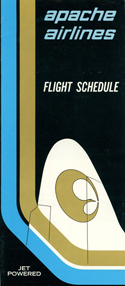 July 1969
July 1969
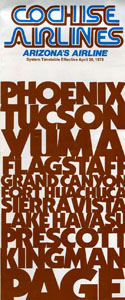 April 1978
April 1978
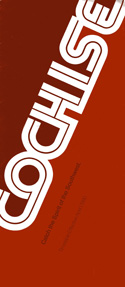 April 1980
April 1980
Cochise Airlines (DP) was started to continue flying the intra-state routes of Apache Airlines which had ceased operations in July 1971, due to a fatal plane crash.
Apache Airlines started as Fixed Base Operator (FBO) at Tucson Airport in 1946, providing flight instruction and charter passenger service. Realizing an opportunity to provide air-service between Tucson and Phoenix, as well as other local airports, Apache received service authority in 1957. For the next ten years, Apache Airlines using de Havilland Dove and Heron aircraft provided service within the State of Arizona, especially its popular Tucson-Phoenix route. By 1970, Apache Airlines had grown to serve nine cities within Arizona and Las Vegas, Nevada but with a downturn in economy and load factors the airline started to suffer financially. The final blow to Apache came on May 6, 1971, when a turboprop conversion de Havilland Dove, "Jetliner 600" crashed enroute to Phoenix from Tucson. The resultant crash and financial aftermath resulting in Apache Airlines stopping operations and filing for bankruptcy.
Hoping to fill a void left by Apache
Airlines, Cochise Airlines started
operations in September 1971, using Cessna 402 aircraft from a Tucson,
Arizona base. Early flights continued the existing Apache route
structure with service to six Arizona communities from both Phoenix and
Tucson including Kingman, Fort Huachuca, Lake Havasu, Prescott, and
Douglas, with most of these routes covered by Essential Air Service (EAS)
contracts. One of the more lucrative routes was a service to Grand
Canyon Airport with weekend flights from Phoenix which was popular with
tourists. Over the next few years Cochise added additional Arizona
cities to its schedule such as Winslow and Page, and leased two de
Havilland DHC-6 Twin Otters from Key Airlines for expansion. By 1977,
Cochise Airlines was flying scheduled passenger services to eleven
cities and communities in Arizona using two Cessna 402 and one DHC-6
Twin Otter aircraft. Considering its operations and extensive route map,
the Civil Aeronautics Board (CAB) recommended that Cochise be issued a
Commuter Airline Certificate, which was granted in 1978, and thus
becoming one of the first “commuter” airlines to receive the
certificate. With the advent of airline deregulation, Cochise sought to
expand past its Arizona borders and looked to serve the West Coast, as
well as placing an order for three Swearingen Metroliners to replace the
Cessna 402 equipment. Authority was granted for the airline to start
service to Los Angeles via El Centro-Imperial and Yuma. This effectively
put Cochise on the “map,” however the “desert” route between Yuma and
Los Angeles was also served by entrenched, regional carrier Hughes Airwest. Service was started to Los Angeles International Airport (LAX)
in April 1979, using the newly delivered Swearingen Metroliners. An
additional route was added from Yuma to Blythe, California located along
the Colorado River. Realizing the need for additional capacity in the
West Coast market, the airline purchased two Convair 440 Metropolitans
which would add twice the capacity of the Metroliners. The existing
fleet of Cessna 402 aircraft was kept, and Cochise marketed charters and
Arizona focused tour packages. During 1981, the airline placed an order
for three SAAB 340 turboprops to eventually replace the Convairs and
started new service to San Diego in July 1981. The non-stop San
Diego-Tucson service used both the Convair and Metroliners and when
flights started became the only airline to serve this market. Although
many of the cities Cochise flew to were subsidized by the EAS contracts
and interline agreements were in place at both Phoenix and Tucson, the
airline started to suffer financially due to competition and expansion
costs. On June 2, 1982 scheduled passenger operations were halted and
both the Convair and Metroliners were grounded. The airline continued to
provide charter and tour packages with the Cessna 402 fleet, however by
the end of 1982, the airline filed for bankruptcy and the assets were
dissolved.
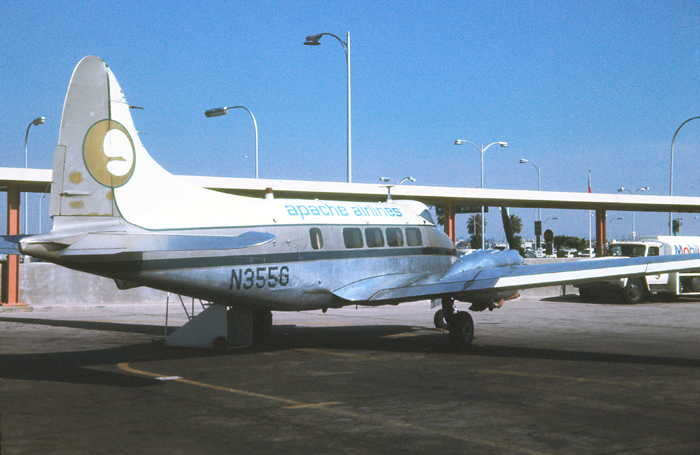 Tucson based Apache
Airlines utilized both the de Havilland Dove and Heron, as well as the
Dove conversion to turboprop by Carstedt, known as the "Jetliner
600" on services throughout Arizona. Parked at the passenger
terminal at Phoenix Sky Harbor Airport in June 1970, is N355G, a de
Havilland DH-104 Dove 5A.
Tucson based Apache
Airlines utilized both the de Havilland Dove and Heron, as well as the
Dove conversion to turboprop by Carstedt, known as the "Jetliner
600" on services throughout Arizona. Parked at the passenger
terminal at Phoenix Sky Harbor Airport in June 1970, is N355G, a de
Havilland DH-104 Dove 5A.
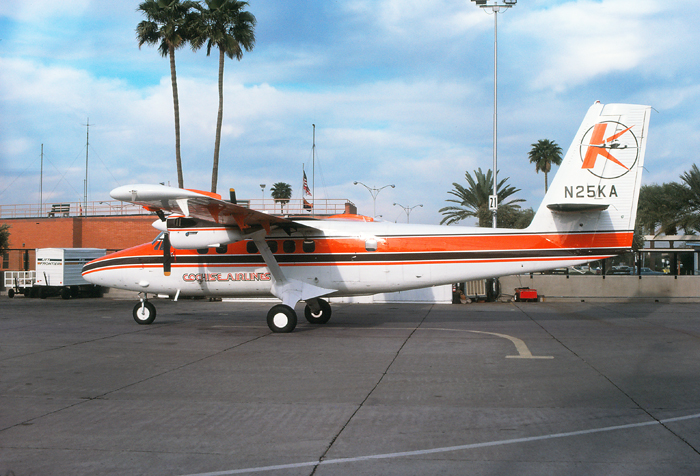 Early passenger
service by Cochise used two leased Key Air Twin Otters bringing
turboprop service to the airline. Parked at the West Terminal and wearing a
hybrid color scheme at Phoenix Sky Harbor International Airport in March
1976, is N25KA, a de Havilland DHC-6-300 Twin Otter.
Early passenger
service by Cochise used two leased Key Air Twin Otters bringing
turboprop service to the airline. Parked at the West Terminal and wearing a
hybrid color scheme at Phoenix Sky Harbor International Airport in March
1976, is N25KA, a de Havilland DHC-6-300 Twin Otter.
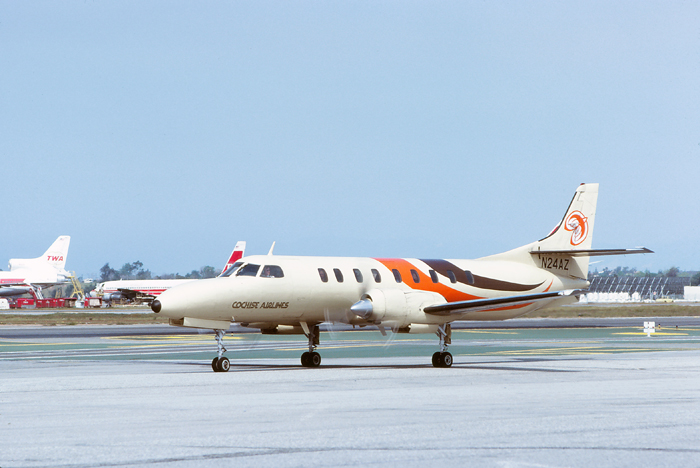 With the
introduction of Metroliner Turboprop equipment in 1978, Cochise Airlines
was able to extend its wings past its Arizona borders and start service
into California and the lucrative Los Angeles market. Taxiing toward the
commuter ramp at Los Angeles International Airport in April 1979, is
N24AZ, a Swearingen SA-226TC Metro II, delivered new to Cochise in
October 1978.
With the
introduction of Metroliner Turboprop equipment in 1978, Cochise Airlines
was able to extend its wings past its Arizona borders and start service
into California and the lucrative Los Angeles market. Taxiing toward the
commuter ramp at Los Angeles International Airport in April 1979, is
N24AZ, a Swearingen SA-226TC Metro II, delivered new to Cochise in
October 1978.
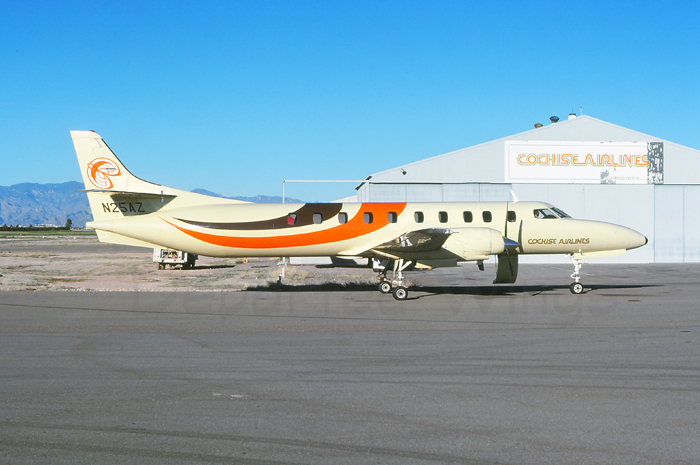 Parked at the
airlines maintenance hangar at Tucson International Airport in March
1979, is
N25AZ, a Swearingen SA-226TC Metro II, delivered new to Cochise in
October 1978.
Parked at the
airlines maintenance hangar at Tucson International Airport in March
1979, is
N25AZ, a Swearingen SA-226TC Metro II, delivered new to Cochise in
October 1978.
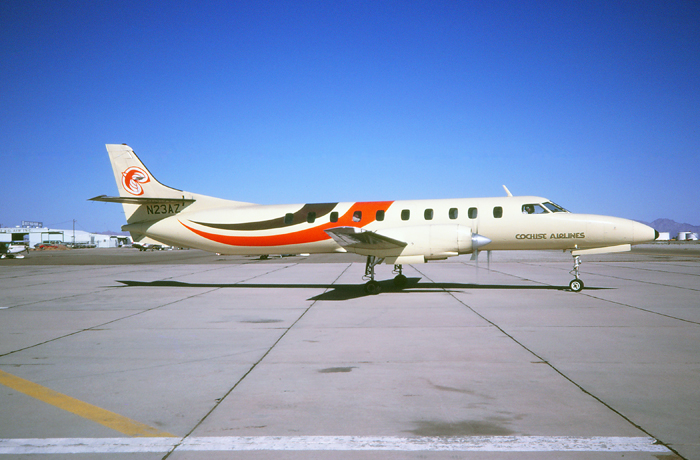 The Metroliners proved popular with passengers for speed and comfort on
flights from Arizona to new destinations in California including Los
Angeles and San Diego. Getting ready to depart the ramp for another
flight at Yuma International Airport in September 1980, is N23AZ, a
Swearingen SA-226TC Metro II, appropriately named "City of Yuma."
The Metroliners proved popular with passengers for speed and comfort on
flights from Arizona to new destinations in California including Los
Angeles and San Diego. Getting ready to depart the ramp for another
flight at Yuma International Airport in September 1980, is N23AZ, a
Swearingen SA-226TC Metro II, appropriately named "City of Yuma."
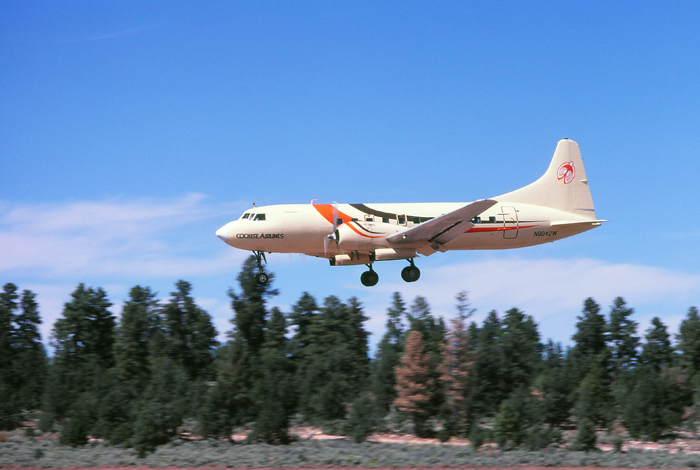 One of the first
airports to be served by Cochise Airlines was Grand Canyon Airport which catered
to tourists on flights from Kingman, Phoenix, and Flagstaff into the
National Park. On approach to Runway 21 at Grand Canyon National Park
Airport in November 1980, is N8042W, a Convair CV-440-75, originally delivered to SAS
Scandinavian in 1958, and purchased by Cochise in 1979.
One of the first
airports to be served by Cochise Airlines was Grand Canyon Airport which catered
to tourists on flights from Kingman, Phoenix, and Flagstaff into the
National Park. On approach to Runway 21 at Grand Canyon National Park
Airport in November 1980, is N8042W, a Convair CV-440-75, originally delivered to SAS
Scandinavian in 1958, and purchased by Cochise in 1979.
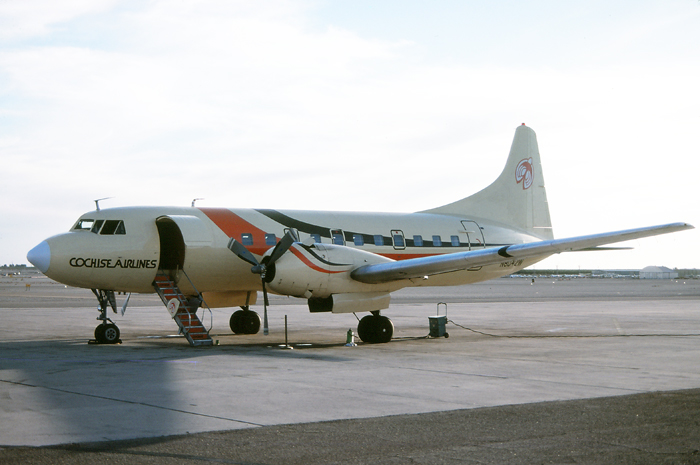 Cochise acquired
the Convair 440 Metropolitan to initially open services to the West
Coast. The larger planes were seen on the Tucson-Yuma-Los Angeles
flights and eventually on non-stop Tucson-San Diego services. Parked on
the ramp at Yuma International Airport and awaiting passengers during a turn-around in March
1981, is N8042W, a Convair CV-440-75.
Cochise acquired
the Convair 440 Metropolitan to initially open services to the West
Coast. The larger planes were seen on the Tucson-Yuma-Los Angeles
flights and eventually on non-stop Tucson-San Diego services. Parked on
the ramp at Yuma International Airport and awaiting passengers during a turn-around in March
1981, is N8042W, a Convair CV-440-75.
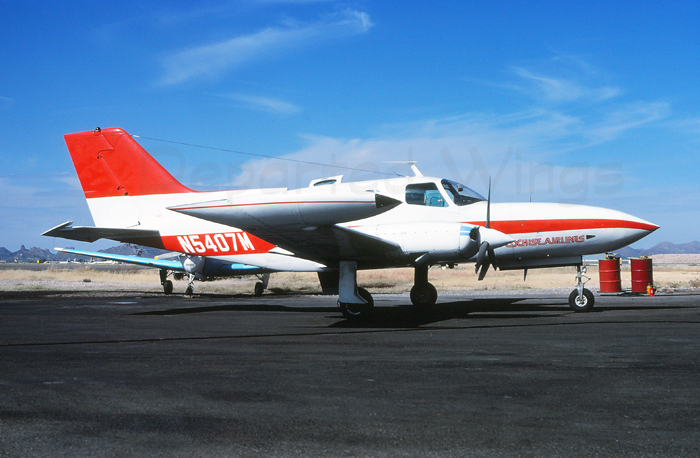 Cochise Airlines
started operations with a Cessna 402 in 1971, and although replaced with
the Convair 440 and Swearingen Metroliners, the small Cessna was still
occasionally used for passenger operations trough 1982. Parked at the
company's base at Tucson International Airport in November 1981, is
N5407M, a Cessna 402B.
Cochise Airlines
started operations with a Cessna 402 in 1971, and although replaced with
the Convair 440 and Swearingen Metroliners, the small Cessna was still
occasionally used for passenger operations trough 1982. Parked at the
company's base at Tucson International Airport in November 1981, is
N5407M, a Cessna 402B.
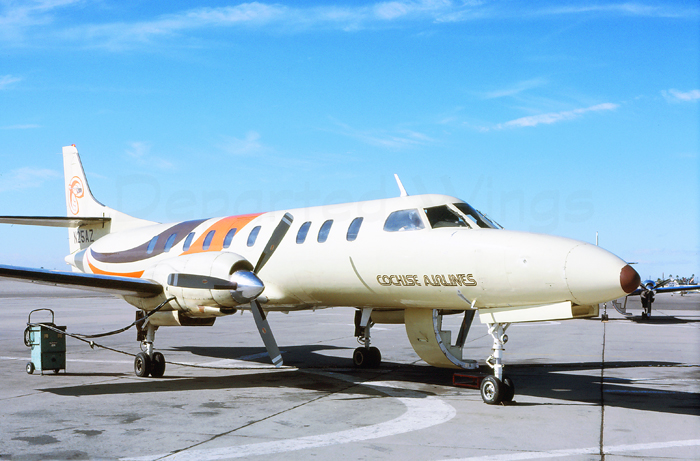 Cochise Airlines
was the largest operator from Yuma in the early 1980s with no less then
twenty flights daily to Blythe, El Centro, Phoenix, and Tucson. Parked
on the ramp and awaiting another load of passengers at Yuma
International Airport in November 1981, is
N25AZ, a Swearingen SA-226TC Metro II.
Cochise Airlines
was the largest operator from Yuma in the early 1980s with no less then
twenty flights daily to Blythe, El Centro, Phoenix, and Tucson. Parked
on the ramp and awaiting another load of passengers at Yuma
International Airport in November 1981, is
N25AZ, a Swearingen SA-226TC Metro II.
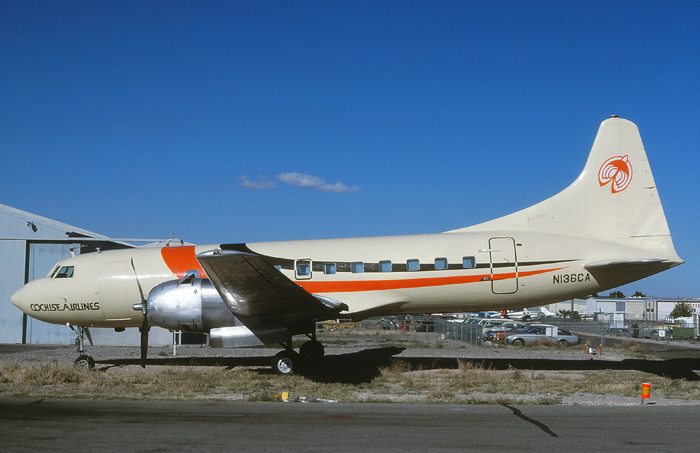 Although the
Convairs had longer range and passenger capacity then the Metroliners,
higher operating costs resulted in the planes being parked by 1982. Seen
in storage and parked at the airlines maintenance hangar at Tucson
international Airport in April 1982, is N136CA, a Convair CV-440-40 Metropolitan.
Although the
Convairs had longer range and passenger capacity then the Metroliners,
higher operating costs resulted in the planes being parked by 1982. Seen
in storage and parked at the airlines maintenance hangar at Tucson
international Airport in April 1982, is N136CA, a Convair CV-440-40 Metropolitan.
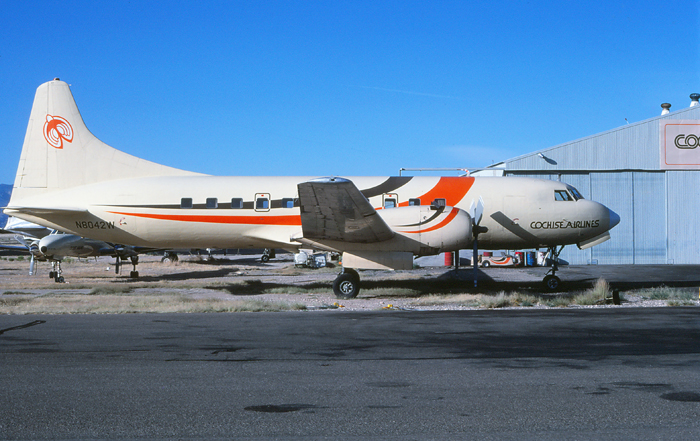 Due to
increased operating costs and lower then forecasted passenger numbers
the two Convair 440s were parked by the summer of 1982 and awaited
disposition to other buyers. Caught being stored at the airlines
maintenance hangar at Tucson International Airport in June 1982, is
N8042W, a Convair CV-440-75 Metropolitan.
Due to
increased operating costs and lower then forecasted passenger numbers
the two Convair 440s were parked by the summer of 1982 and awaited
disposition to other buyers. Caught being stored at the airlines
maintenance hangar at Tucson International Airport in June 1982, is
N8042W, a Convair CV-440-75 Metropolitan.
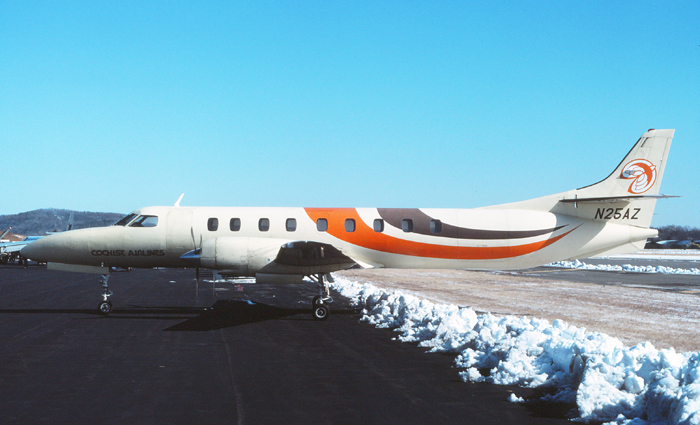 After the carrier
was shut-down and dissolved in the summer of 1982, the Metroliners were
stored pending a buyer, of which Air Virginia purchased all three planes
in 1984. Parked on a rather cold ramp at the Air Virginia base in
Lynchburg, Virginia
and awaiting repainting in April 1984, is N25AZ, a Swearingen SA-226TC
Metro II.
After the carrier
was shut-down and dissolved in the summer of 1982, the Metroliners were
stored pending a buyer, of which Air Virginia purchased all three planes
in 1984. Parked on a rather cold ramp at the Air Virginia base in
Lynchburg, Virginia
and awaiting repainting in April 1984, is N25AZ, a Swearingen SA-226TC
Metro II.